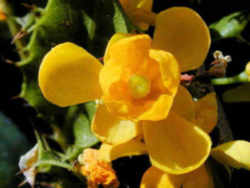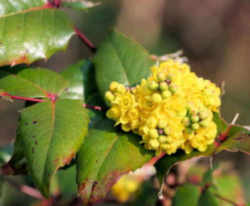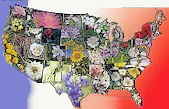Oregon State Flower
Oregon Grape

(Berberis aquifolium)
Adopted in 1899.
Oregon Grape was adopted in 1899 by Senate Concurrent Resolution Number Four of the Oregon Legislative Assembly, the State of Oregon on January 30-31, 1899 as Oregon official state flower.
A low growing plant, the Oregon Grape, (Berberis aquifolium,) is native to much of the Pacific Coast and found sparsely east of the Cascades.
Its year-round foliage of pinnated, waxy green leaves resembles holly. The plant bears dainty yellow flowers in early summer and a dark blue berry that ripens late in the fall. The fruit can be used in cooking. Oregon grape is a close relative of barberry (Berberis vulgaris), and as with its cousin, the plant's medicinal portion is the root. Although Oregon grape originated in North America, it now also grows in Europe.
Oregon State Flower: Oregon Grape

Oregon grape is a low-growing shrub from 2 to 5 feet in height, resembling the holly of the Eastern States. The leaves are divided like those of an ash; the five to nine leaflets from 2 to 3 inches long and about 1 inch wide are evergreen, thick, leathery, smooth, and shining on the upper surface with marginal spines. The numerous small yellow flowers appear in April and May and are borne in erect clusters. The fruit consists of a cluster of blue berries. The rootstock and roots are more or less knotty, about an inch or less in diameter, with tough yellow wood and brownish bark.
Characteristics of the Oregon Grape
- Other Common Names: Agrecillo, Berberi, Epine Vinette, Holly-Leaved Barberry, Holly-leaf Oregon-grape, Mahonia, Mountain Grape, Yerba De
Sangre, Mahonia aquifolium, Berberis aquifolium
- Leaf: Pinnately compound (oddly), alternate, persistent; 10 to 18 inches long, 11 to 21 broadly lanceolate leaflets each 2 to 3 inches
long. Leaflets are dark, glossy green above and paler green below; thick, waxy cuticles and spined teeth along their margins. Lateral leaflets are
opposite and sessile, while the terminal leaflet has a petiole; leaflets lack a distinct midrib.
- Flower: Monoecious, perfect, small bright yellow flowers are borne in long, upright racemes.
- Fruit: Small (3/16 inch), dark blue berries, edible, but sour.
- Twig: Unbranched; compound leaves emerge directly from main stem. Main stem is stout and brown; leaves are clustered at the terminal end.
Lanceolate bud scales persist for several years.
- Bark: Reddish brown, scaly and rough.
- Form: A short, erect, unbranched evergreen shrub seldom over 3 feet
- Habitat and range. - This shrub is native in woods in rich soil among rocks from Nebraska to the Pacific Ocean, but it is especially abundant in Oregon and northern California.
Oregon Revised Statutes
The law designating the Oregon grape as the official Oregon state flower is found in the Oregon Revised Statutes, Title 19, Chapter 186. Senate Concurrent Resolution No. 4 is cross-referenced in chapter 186.
TITLE 19. MISCELLANEOUS MATTERS RELATED TO GOVERNMENT AND PUBLIC AFFAIRS.
CHAPTER 186. State Emblems; State Boundary.
CROSS-REFERENCES.
Oregon grape declared to be official flower, SCR 4 (1899)
Taxonomic Hierarchy: Oregon Grape
Kingdom: Plantae - Plants
Subkingdom: Tracheobionta - Vascular plants
Superdivision: Spermatophyta - Seed plants
Division: Coniferophyta - Conifers
Class; Magnoliopsida - Dicotyledons
Subclass: Magnoliidae -
Order: Ranunculales -
Family: Berberidaceae - Barberry family
Genus: Mahonia Nutt. - barberry
Species: Mahonia aquifolium (Pursh) Nutt. - hollyleaved barberry
State Floral Emblems








